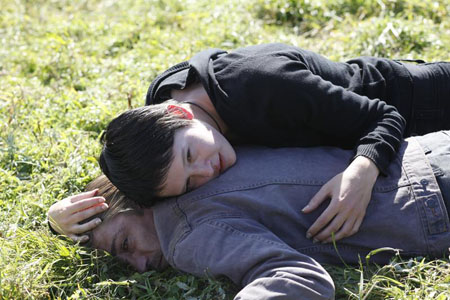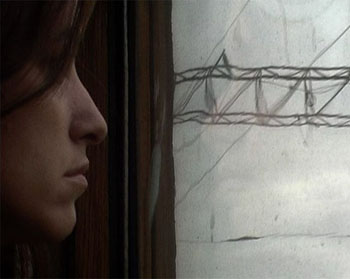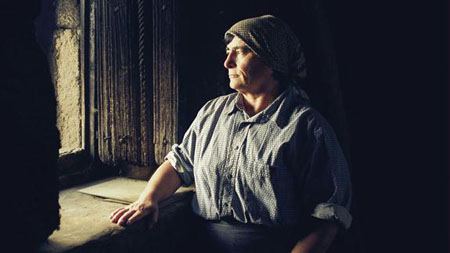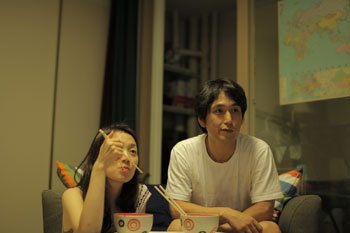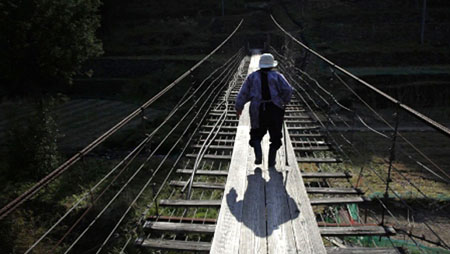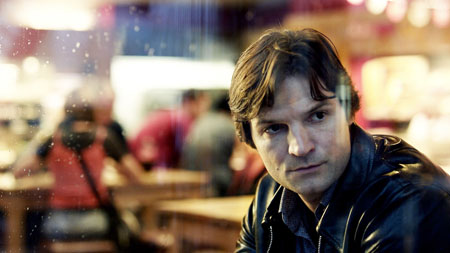“For the second year running the First Look series at the Museum of the Moving Image (January 4 – 13) provides an invaluable showcase for undistributed international cinema,” writes R. Emmet Sweeney in a terrific overview of this year’s edition at Movie Morlocks (you may remember the entry on the lineup posted almost exactly one month ago now). “Programmers Rachael Rakes, Dennis Lim and David Schwartz pluck adventurous work from festivals around the world, tracking developments in documentary form, the Berlin School, Korean indies and the continuing vibrancy of Portuguese film culture. In a clue as to the series’ disregard of commercial impulses, the series’ opening night film is Hors Satan, the latest by the divisive arthouse provocateur Bruno Dumont. Operating as a relatively youthful version of the New York Film Festival, First Look is an attempt to clue its audiences in to the possible future of the medium.” And he reviews Thomas Arslan’s In the Shadows, Jang Kun-jae’s Sleepless Night, Thom Andersen’s Reconversão (Reconversion), and the “most indelible entries in the shorts program,” Mati Diop’s Snow Canon and Kleber Mendonca Filho’s Eletrodomestica.
As it happens, Hors Satan is opening in the UK today as well. “Devotees of Dumont’s earlier films—particularly his 1999 film Humanity—will instantly recognize the style, the locale, the narrative, the bizarre quasi-realism, in which events take place in a world infinitesimally different from the one we inhabit,” writes the Guardian‘s Peter Bradshaw. “As ever, the visionary, radioactive glow is compelling…. David Dewaele is an actor who had a small part in Dumont’s earlier film Hadewijch, and he returns here in a much larger but not dissimilar role: it is tempting to wonder if he is in fact playing the same role, further down the road. He is unnamed, a drifter, or perhaps a traveller (there is some talk about his “camp”) who sleeps rough huddled by a broken wall on the beach, pitching campfires. He has formed an intense friendship with a lonely, goth‑ish young woman (Alexandra Lemâtre), who has confided to him that she is being abused by her stepfather.”
“Is the hero an atheist’s version of a messiah?” asks Nigel Andrews in the Financial Times. “A Christly Antichrist? Dumont is an unbeliever who makes obsessively religion-referencing movies. His poacher is a miracle-working drifter like Terence Stamp in Pasolini‘s Theorem. Hors Satan sometimes seems completely mad: a wind-torn, lyrical, savage, gnomic doodle at once aleatory and alea iacta est. Everything seems both ungovernably random and fatalistically predestined, a passable summation of how life appears to many of us most of the time. As an artist Dumont was under tighter self-control in his best film to date, Flanders. Even so, to paraphrase Shakespeare, madness in gifted ones, or eccentricity at once errant and forthright, must not unwatched go.”
Scott Foundas in the Voice: “Dumont surfaces elsewhere in the First Look lineup, as co-star and general co-conspirator of actress-director Joana Preiss’s debut feature, Siberia (Sibérie), a sui generis film à clef in which Preiss and Dumont—at the time of filming, a real-life couple—take a ride on the Trans-Siberian Railway, their relationship variously expanding and contracting with each new bend in the track. In stark contrast to the painterly CinemaScope vistas of Dumont’s own film, the style here is grainy, full-frame DV, each partner recording the other in various states of physical and emotional undress.” He also reviews James Benning’s “fascinating” Easy Rider, Pedro González-Rubio’s Inori, and Hors Satan.
Tony Pipolo opens his overview for Artforum with Greatest Hits, “Nicolás Pereda‘s latest exercise in downbeat Mexican life. Gone are the framing strategies of his previous films that gave the illusion of some vague theme making sense of eventless existence. In his new work, people hang around at the kitchen table or the living-room couch—two of them played by Pereda regulars Gabino Rodríguez and Teresa Sánchez—chatting idly and endlessly about nothing much. No one is rushing off to work, although they talk a lot about schemes for making money. Just as we’ve resigned ourselves that nothing unusual is likely to happen, the long-lost husband and father of Sánchez and Rodríguez arrives, although another actor had been playing that part in the first half. Then, when members of the film crew pop up, we think maybe we’ve been watching a Mexican version of the landmark television series An American Family (1973). Or perhaps everything we’ve seen thus far is another memorization exercise, like the one Gabino rehearses over and over of song titles (the ‘greatest hits’ of the title). Handsomely shot in wide-screen with an emphasis on long takes, the film has a sly way of getting under your skin, as if these entrapped lives—fictional or non—were the comic underside of the lives of those fools in the rest of the world consumed by business and purpose.”
Updates, 1/5: The Museum’s Moving Image Source has posted two articles, the first by Miguel Gomes (yes, that Miguel Gomes) on Manuel Mozos, whose feature Xavier and short Noelia screen tomorrow: “As I see it, Manuel is the one great Portuguese filmmaker who has been denied the international acclaim he is due; but I am not alone in feeling strongly for him and his films. The two key figures of 1960s filmmaking and pioneers of modern Portuguese cinema are closely linked to his work: Fernando Lopes (Belarmino, 1963) asked him to make his first, hour-long film for Portuguese television, Um passo, outro passo e depois (A Step, Another Step, and Then). And the late Paulo Rocha (Os Verdes Anos, 1962) took on the production and finishing costs for Manuel’s second film, Xavier, which, for lack of money, awaited completion for many years.”
The other piece is Michael Sicinski‘s on Eloy Enciso’s Arraianos, which “dips directly into narrative or fictional cinema, but does so in a way that partakes of a particular tradition, one as radical within its own mien as the Flaherty or Gardner approaches are within ethnography.”
America is on J. Hoberman‘s mind as he considers three “movies out to evoke what D.H. Lawrence called ‘the spirit of the place.'” One of these is Benning’s Easy Rider, “a leisurely succession of beautifully framed, static landscape shots, more or less corresponding to the locations in the 1969 movie, and accompanied by bits of dialogue from the movie’s soundtrack. It’s not subtle (after Peter Fonda’s heartfelt ‘we blew it,’ Benning cuts to a shot of a steam-belching oil refinery) but when the filmmaker throws in Space Lady Suzy Soundz’s acid reverb version of ‘Born to Be Wild’ or uses a close-up of creepy jail house graffiti (‘I Love God’) for Jack Nicholson’s first scene, his Easy Rider is both a weird tribute to original’s mythic power and an evocation of an America haunted, as Lawrence imagined it, by ‘grinning, unappeased aboriginal demons.'” (The other two films, by the way, are Gus Van Sant’s Promised Land and Walter Salle’s On the Road.)
For the New York Times, Saul Austerlitz talks with Thom Andersen about Reconversão, his documentary essay on Eduardo Souto de Moura, the 2011 winner of the Pritzker Prize for architecture, who “incorporates shards of the past—half-demolished walls, 14th-century waterworks, even his own disintegrating older structures—into new designs, choosing to embrace, rather than elide, the crumbling remnants of history. Mr. Andersen too has constructed a career around shoring up ruins, recombining and recontextualizing fragments of cinematic history into dazzling new forms. The process has resulted in disparate works of cinematic excavation like Eadweard Muybridge Zoopraxographer (1974), about the 19th-century artist who used photography to study humans and animals in motion; Red Hollywood (1995), about the films of blacklisted American writers and directors; and Los Angeles Plays Itself (2003), an illustrated lecture documenting the film industry’s mixed record of depicting its hometown.” As for Reconversão, Andersen says, “Architecture is the one art that we can’t escape. We can choose not to look at paintings, not to listen to music, not to read books, but we can’t avoid architecture.”
In his overview of the First Look program for Filmmaker, Paul Dallas writes that “Kun-jae’s seemingly straightforward Sleepless Night might be channeling Ozu by way of Claire Denis. Winner of several top prizes at the Jeonju Film Festival, the director’s second feature is an intimate portrait of a working-class thirty-something couple, still in the glow of the first years of marriage, and pondering the leap into parenthood. This gentle and exquisitely observed film achieves an impressive emotional poignancy due in large part to the fine direction and wonderful lead performances. Realistic in the best sense, Sleepless Night captures the drama of the present moment in daily life—which is neither predictable nor obviously dramatic, but nonetheless thoroughly engrossing.”
Sight & Sound is running Tony Ryans‘s review of Hors Satan—with a spoiler alert.
“Furtive and feverish yet bathed in an incandescent tranquility, the films of Mati Diop reside in the realm of the senses,” writes Andréa Picard for Moving Image Source. “The sly charms of her cinema ebb and flow at their own pace, troubling the very unusual serenity that emerges from the young director’s diaphanous images, which hover and hesitate just like the characters they portray. Known increasingly for her trio of award-winning and highly original short films—Atlantiques (2009), Snow Canon (2011) and Big in Vietnam (2012)—Diop first came to light as a non-professional actress playing the stunning, stoic daughter in Claire Denis’s 35 Rhums (35 Shots of Rum, 2008), whose rapturous, unforgettable ‘Night Shift’ scene became an instant cinephile fixation; not as euphoric as Denis Lavant’s breathless dancing salvo in Beau Travail, but fetish-worthy just the same with its rain-soaked, sexual slow dancing and stealthy, longing gazes. Diop’s widely praised performance led to subsequent roles, most recently as a beguiling French prostitute in Antonio Campos’s Simon Killer. She’s also, as her name reveals, from an august cinephilic family lineage, the niece of legendary Senegalese auteur and poet Djibril Diop Mambéty (Touki Bouki, La Petite vendeuse de soleil) and daughter of jazz musician Wasis Diop, a celebrated sound composer, most notably for the films of Mahamet Saleh Haroun.”
Update, 1/9: In the Notebook, Fernando F. Croce writes up Hors Satan, Reconversão, Revision, Kleber Mendonça Filho’s shorts, Xavier, and González-Rubio’s Inori: “The mountainous Japanese village of Kanagawa is the setting, a realm of stilled landscapes and slowed-down rhythms. With all of the younger residents having left in search of jobs, the only remaining inhabitants are a handful of elderly dwellers literally waiting for the sun to set; their mundane activities—sweeping sidewalks, placing flowers on graves, flipping through picture albums, praying to private shrines, ambling down to a makeshift clinic—make up the bulk of this gentle documentary. Death and the hereafter (casually referred to as ‘the other side’) are palpable presences in this twilight netherworld, where people band together out of necessity as much as out of emotion: in an oddly funny shot, a couple sitting on the floor by a boiling kettle are asked about their marriage, and with a fond shrug the husband says that they don’t have the strength to live alone. The subject sounds forlorn, but González-Rubio brings to it the alert, virginal gaze he lavished on the coral-reef family in Alamar, a connection of people and environments worthy of a veteran like Jan Troell.”
Updates, 1/12: From Leo Goldsmith‘s overview in the Brooklyn Rail: “Urgent and sprawling, Winter, Go Away! is a remarkable, immediate account of the days before and after the 2011 Russian election, shot handheld and from the hip by 10 filmmakers and former students of the filmmaker Marina Razbezhkina at her School of Documentary Film and Documentary Theatre. Amid nationalist and pro-Putin fervor, opposition activists from various parties struggle for footholds in a democratic process gone awry, and are met with swift and Kafkaesque responses from authorities. Pussy Riot’s offending incident at the Cathedral of Christ the Savior in February 2012 (which the film captures) is only the most familiar example. But alongside this event, the film presents a litany of infuriating and surreal encounters, including police thuggery, denial of the freedom of the press, and blatant election official high jinks, culminating in the protests of December 2011, which resulted in hundreds of arrests. Most maddening of all is the endless, self-satisfied apologia from devotees of Putin’s insidious personality cult, the nadir of which, we soon learn, is a small church called the Chapel of Russia’s Resurrection, which claims to have an icon of the once and future president that actually weeps.”
Moving Image Source has posted three more pieces, one of them being Boris Nelepo‘s on Winter, Go Away!: “Whether this film was oppositional or counter-revolutionary was the subject of a fierce controversy in Russia. The directors intentionally avoid taking any sides while watching everyone with incredible vigilance. Speech is the least reliable manifestation of a man, argued Razbezhkina, while urging her students to focus on movements and gestures.”
Michael Sicinski writes that, “if there is a balance within Berlin School cinema between the embrace of genre elements and an exacting, constructivist formalism, then In the Shadows finds [Thomas] Arslan tipping that balance ever so slightly toward those generic elements which, in turn, reflect a slight nudge toward a certain level of accessibility. This is impressive, because it instigates a highly engaging dialectic that, in its own way, motors In the Shadows even more than the plot itself. The film is a patient but propulsive portrait of a very opaque man, rendered in surfaces and textures that capture the icy gleam of late capitalism ‘after dark.’ Arslan has created a work of art so polished and vacuum-sealed that it stands as a kind of mirror to its audience’s expectations.”
Phil Coldiron: “Just as Souta de Moura’s projects take past and present as two faces of a continuous whole, Reconversão‘s images are at once aggressively contemporary (in their textures, colors, and quality of light) and resolutely atavistic in their incorporation of a facsimile of an essential trait of film that the digital image will never truly replicate.” More on Reconversão at Artinfo, from both J. Hoberman and David D’Arcy.
For news and tips throughout the day every day, follow @KeyframeDaily on Twitter and/or the RSS feed. Get Keyframe Daily in your inbox by signing in at fandor.com/daily.

